Handcrafted Community
Placemaking initiatives take off in the Fox Cities
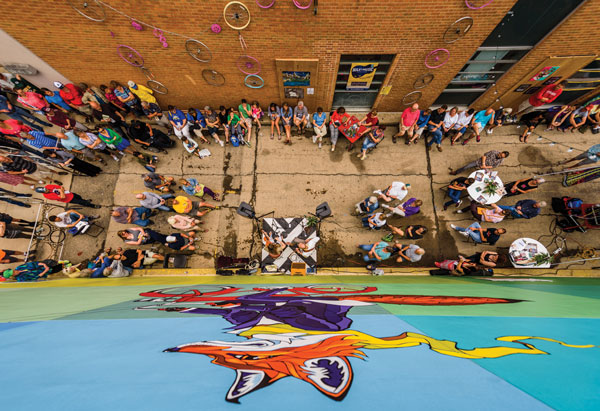
Photo by Graham Washatka of Graham Images, grahamimages.net
Cities across the country are feeling a sense of urgency when it comes to creating a sense of place, and the Fox Cities are no exception. From enhancing cultural programs to beautifying public spaces, urban developers often refer to this intentional curation of a community as placemaking — a term that causes supporters to celebrate and critics to cringe.
Call it what you will, Josh Dukelow, who serves on Appleton Downtown Inc.’s Board of Directors and Creative Downtown Committee, says that some of that urgency has to do with talent attraction and retention.
“People are deciding where they want to be based on the amenities, the opportunities and experiences that place offers. Once they get there, then they figure out how to pay the bills,” he says. “That has really put an emphasis on communities to be a destination.”
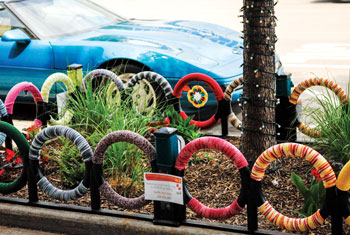 From murals and festivals to parks and pop-ups, examples of destination creation are abundant throughout Northeast Wisconsin. But, at its core, what does placemaking mean, really?
From murals and festivals to parks and pop-ups, examples of destination creation are abundant throughout Northeast Wisconsin. But, at its core, what does placemaking mean, really?
Dukelow says that in some ways, the term placemaking has become a catchall for what makes a city desirable, a sort of intrinsic vibe that draws people. The result? Economic growth and stability.
“Placemaking really is just about activating public spaces,” Dukelow says. “It’s been around a long time, now we have a word to describe it. And now we are putting it into action here.”
Creating Spaces
Future Neenah Director Amy Barker stands in Gateway Plaza, overlooking the undeveloped land on the south end of Little Lake Butte des Morts, known as Arrowhead Park. Just off the park’s shores, two new trestle bridges are set for construction next spring as part of the Loop the Little Lake Trestle Project which will connect the existing trail system.
The area has long been industrial, but that may change. With the new development routing the trail’s 350,000 annual visitors to the edge of downtown Neenah, Barker sees the shoreline as a blank canvas for public art, such as large-scale sculpture, to harken visitors further into the city.
“When we’re creating new spaces like these for economic development purposes, sometimes you have to infuse a little bit of creativity into them to create that draw, especially when we are dealing with places that the community isn’t used to visiting,” Barker says. “It needs to feel like a purposeful place where you want to linger.”
Purposefulness is a cornerstone of placemaking, one that is at the forefront of urban design. Take the newly developed community space between Wild Apple Gallery and Your Daily Grind coffee shop in downtown Menasha. Cafe lights were strung between the buildings and a 12-person social table was added to encourage community gatherings and create a more welcoming atmosphere.
Another example of this urban space upcycling can be found between Appleton’s 222 building and Copper Rock Coffee on College Avenue. Last year, the vacant 1,120 square-foot space was transformed into Parklet Place, a miniature urban park with functional seating and tables, handmade flower planters, decorative lighting and a small stage for live performances. A mural was painted by the community which Dukelow says plays a big part in garnering public support for these projects.
“When people can see their fingerprints on their city, that helps to build that civic pride and buy in,” he says. “It’s one thing to see a piece of art that’s pretty. It’s another thing to participate in creating it.”
But support for placemaking initiatives isn’t always easy to come by.
“Sometimes creative placemaking can be a tough sell because it’s harder to measure the economic impact,” Barker says. “You might not know exactly why you were drawn to a space or be conscious of the fact that it was that mural or bike rack that made you feel invited.”
Engaging the broader community is step one to gaining support. In September, ADI launched a placemaker workshop program to involve area businesses in the placemaking process. In the workshops, teams from participating businesses identify places in Downtown Appleton to be enhanced through urban design, accessibility and art. They then conceive and execute their own placemaking project. The hope is that employees will feel more connected to the place they live and will result in quality public spaces that enhance health, happiness and well-being.
“We’ve had some major local employers find that placemaking work really resonates with them,” Dukelow says. “That is the next level of engagement. You aren’t just supporting what’s going on, you’re doing it.”
Authenticity in Action
Elevating what organically exists in a place is key to maintaining authenticity, says Dukelow, who points to the Little Chute Windmill as an example of a destination that is true to the character of its community. The same holds true for programming.
“When Kaukauna wanted to start their music festival, they didn’t call it ‘The Other Mile of Music.’ They called it the Electric City Experience. It’s true to their heritage of electric power generation,” Dukelow says.
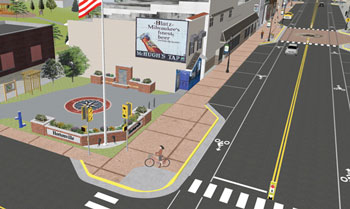 Authentic placemaking is on the mind of Hortonville Village Administrator Diane Wessel as her community prepares for the State 15 bypass reconstruction. To ensure Hortonville’s downtown stays viable, the village worked with the East Central Wisconsin Regional Planning Commission (ECWRPC) and a group of Northcentral Technical College students to develop the Hortonville 2020 Vision project.
Authentic placemaking is on the mind of Hortonville Village Administrator Diane Wessel as her community prepares for the State 15 bypass reconstruction. To ensure Hortonville’s downtown stays viable, the village worked with the East Central Wisconsin Regional Planning Commission (ECWRPC) and a group of Northcentral Technical College students to develop the Hortonville 2020 Vision project.
“It’s all about tying the whole community together and making it more pedestrian and bicycle-friendly and creating a more friendly atmosphere for everybody,” says Nick Musson, associate transportation planner with ECWRPC.
Wessel gathered input for the project through community visioning sessions. In addition to creating a public space and emphasizing the area’s natural amenities, participants hoped the developments would highlight Hortonville’s unique history.
“The community really wanted to see that historic character,” Wessel says. “We have some, but it’s a little eroded from the downtown feel. We want to bring it back.”
Plans for new developments were based on historical images of Hortonville in an effort to regain some of that classic, small town charm. Wessel believes this kind of placemaking will result in a more robust local economy.
“It would make Hortonville a place more people would want to come to, raise their families here and support our businesses,” she says. “I think strengthening our community would result in all of that.”
Engagement & Interaction
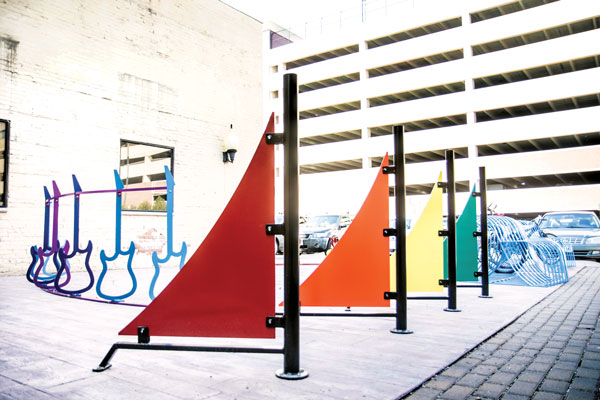
Neenah’s new bike racks are themed on values of the community.
Photo by Adam Shea of Adam Shea Photography, adamsheaphoto.com
Seating and scenery might establish a space, but programming is what brings it to life.
“Building the space is step one,” Barker says. “Programming challenges us to stay on the cutting-edge and see what excites people.”
In August, Future Neenah announced the retirement of Streetball, an iconic, 25-year-old Neenah event. Barker says this gives Future Neenah the chance to establish new programs that reflect the local culture and nurture Neenah’s potential, possibly with events the area hasn’t seen before.
“When we look to new opportunities, I’m very conscious of being authentic to who we are,” she says. “We have to figure out what’s here, what exists and what we can celebrate.”
Barker says that effective placemaking is more than good marketing. Whether it’s a public art project or summer concert series, placemaking initiatives have the power to share a city’s narrative in a new way.
“It’s just a different way to tell our story,” Barker says, “and we have some really awesome stories to tell.”
—FC









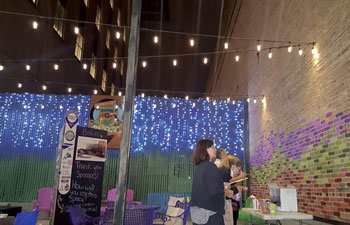

Leave a Comment